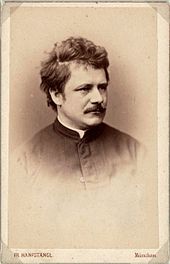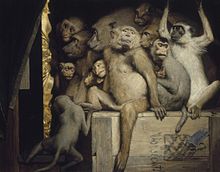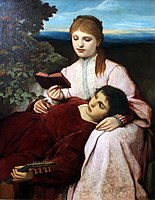art.wikisort.org - Artist
Gabriel Cornelius Ritter von Max (23 August 1840 – 24 November 1915) was a Prague-born Austrian painter.
This article may be expanded with text translated from the corresponding article in German. (April 2010) Click [show] for important translation instructions.
|

Biography

He was born Gabriel Cornelius Max, the son of the sculptor Josef Max and Anna Schumann. He studied between 1855 and 1858 at the Prague Academy of Arts with Eduard von Engerth. His studies included parapsychology (somnambulism, hypnotism, spiritism), Darwinism, Asiatic philosophy, the ideas of Schopenhauer, and various mystical traditions. The spiritual-mystical movement was emphasized by the writings of Carl du Prel, and the Munich painter Albert Keller was also an influence.[1]
His first large canvas was painted in 1858 while he was a student at the Prague Academy. He continued his studies at the Viennese Academy of Art with Karl von Blaas, Karl Mayer (painter), Christian Ruben and Carl Wurzinger. From 1863 to 1867 he studied at the Munich Academy with Karl Theodor von Piloty, and also Hans Makart and Franz Defregger. His first critical success was in 1867 with the painting "Martyr at the Cross": that painting transformed the "Unglücksmalerei" (dark palette) of Piloty into a religious-mystical symbolism using a psychological rendering of its subject.

He continued to use the dark palette of the Piloty school well into the 1870s, later moving toward a more muted palette, using fewer, clearer colors. From 1869, Gabriel von Max had his studio in Munich; in the summer, he was in Ammerland, and from 1893 in Ambach at Starnberger Lake. From 1879-1883, Gabriel Max was a professor of Historical Painting at the Munich Academy; he also became a Fellow of The Theosophical Society. In 1900 he was ennobled and became a Ritter. He died in Munich in 1915.
His interest in anthropological studies also showed in his work. He owned a large scientific collection of prehistoric ethnological and anthropological finds: the collection and his correspondence now reside in the Reiss-Engelhorn-Museen in Mannheim. In a garden house in Munich, Gabriel Max kept a herd of monkeys from 1869 to about 1873, which he photographed and sketched. Later he used the material for large paintings in which he sometimes depicted the animals as people. Max, along with his colleagues, often used photographs to guide painting. The great number of monkey photographs in his archive testify to their use as direct translation into his paintings. In 1908, his painting "The Lion's Bride" became celebrated, and was depicted in motion pictures as an hommage in the Gloria Swanson film, Male and Female, (1919), directed by Cecil B. de Mille.
Gabriel von Max was a significant artist to emerge from the Piloty School, because he abandoned the themes of the Grunderzeitliche (genre and history), in order to develop an allegorical-mystical pictorial language, which became typical of Secessionist Art. Characteristic of the ethereal style of Gabriel Max is "The Last Token" (in the Metropolitan Museum), and "Light" (in the Odessa Museum of Western and Eastern Art, Ukraine).
The largest collection of the work of Gabriel von Max in the United States is held by the Jack Daulton Collection in Los Altos Hills, California.[2] Also, Gabriel von Max's work can be found in the collection of Milan Jovanović Stojimirović who bequeathed his vast collection of paintings and artifacts to the Art Department of the Museum in Smederevo.[3]
- Gabriel von Max: Äffchen mit Zitrone; Sauere Erfahrungen (Monkey with Lemon; Bitter Experiences), The Jack Daulton Collection, Los Altos Hills, California[4]
- Tannhäuser (c. 1878), National Museum, Warsaw
- Light
- Martyress
- Lady Macbeth
- Blonde Frau mit Seidenschleier - Blonde young girl wiyth a veil.
- Young woman with flowers in her hair
- The reading ape
 Going to Sleepǃ
Going to Sleepǃ- The ecstatic virgin Katharina Emmerich
 The leisure hour anagoria
The leisure hour anagoria
References
- "Period archives biography". www.iment.com. Retrieved March 4, 2015.
- "Gabriel von Max Collection". www.gabrielvonmax.com. Retrieved Jul 26, 2022.
- The Legacy of Milan Jovanovic Stojimirovic in the Art Department of the Museum in Smederevo. www.academia.edu.
- "Gabriel von Max". www.gabrielvonmax.com.
Sources
- Agathon Klemt: Gabriel Max und seine Werke, Gesellschaft für moderne Kunst, Wien 1886
- Nicolaus Mann: Gabriel Max, eine kulturhistorische Skizze, Weber, Leipzig 1890
- Franz H. Meißner: Gabriel von Max, Hanfstaengl, München 1899
- Johannes Muggenthaler (Hrsg.): Der Geister Bahnen. Eine Ausstellung zu Ehren von Gabriel von Max, 1849-1915, Mosel & Tschechow, München 1988, ISBN 3-925987-03-7
- Harald Siebenhaar: Gabriel von Max und die Moderne, in: Klaus G. Beuckers (Hrsg.): Festschrift für Johanne Langner, Lit Verlag, Münster 1997, ISBN 3-8258-3209-0
- Thieme-Becker, Bd.XXIV, pp. 288/289.
- Adolf Rosenberg, The Munich School of Painters and their development since 1871, Hanover 1887, pp. 15–18.
- Fritz von Ostini, Nachruf auf Gabriel von Max in: Muncher Neueste Nachrichten, 1915.
- Cat. Neue Pinakothek, Munich. Bd. VI, Painters of the Grunderzeit, Editor Horst Ludwig. Munich 1977, pp. 238–243.
- Ausst, Cat. Neue Pinakothek, Munich. The Munich School 1850-1914, Munich 1979, pp. 304–307.
- Klaus Popitz, The Fruhe Poster in Europe and the USA, Vol.3, Germany.
- Jo-Anne Birnie Danzker (Ed.): Gabriel von Max, Frye Art Museum, Seattle 2011, ISBN 978-0-295-99146-7
External links
 Media related to Gabriel von Max at Wikimedia Commons
Media related to Gabriel von Max at Wikimedia Commons- Collection of Works by Gabriel von Max
- Period archives biography Retrieved 19-08- 2008
- Art Renewal Center Gallery Retrieved 19-08- 2008
- Gabriel von Max's "Bitter (Sour) Experiences", a conversation between art historian Jennifer Tonkovich and art collector Jack Daulton, part 1
- Gabriel von Max's "Bitter (Sour) Experiences", a conversation between art historian Jennifer Tonkovich and art collector Jack Daulton, part 2
На других языках
[de] Gabriel von Max
Gabriel Cornelius Ritter von Max (* 23. August 1840 in Prag, Kaisertum Österreich; † 24. November 1915 in München; bis 1900 Gabriel Cornelius Max) war ein deutscher Maler und Professor für Historienmalerei an der Königlichen Akademie der Bildenden Künste, Darwinist und Spiritist.- [en] Gabriel von Max
[fr] Gabriel von Max
Gabriel Cornelius Ritter von Max et jusqu'en 1900 Gabriel Cornelius Max (né le 23 août 1840 à Prague - mort le 24 novembre 1915 à Munich) est un peintre autrichien né en Bohême, qui a été professeur d'histoire de la peinture à l'Akademie der Bildenden Künste de Munich. Ses thèmes picturaux sont l'anthropologie, la parapsychologie et le mysticisme. Il fait partie de l'école de Munich.[it] Gabriel von Max
Gabriel Cornelius von Max (Praga, 23 agosto 1840[1] – Monaco di Baviera, 24 novembre 1915) è stato un pittore tedesco.[ru] Макс, Габриэль
Габриэль Макс (нем. Gabriel Cornelius Ritter von Max; (23 августа 1840, Прага — 24 ноября 1915, Мюнхен) — один из значительных немецких живописцев.Другой контент может иметь иную лицензию. Перед использованием материалов сайта WikiSort.org внимательно изучите правила лицензирования конкретных элементов наполнения сайта.
WikiSort.org - проект по пересортировке и дополнению контента Википедии
![Gabriel von Max: Äffchen mit Zitrone; Sauere Erfahrungen (Monkey with Lemon; Bitter Experiences), The Jack Daulton Collection, Los Altos Hills, California[4]](http://upload.wikimedia.org/wikipedia/commons/thumb/0/08/Gabriel_von_Max_%C3%84ffchen_mit_Zitrone.jpg/140px-Gabriel_von_Max_%C3%84ffchen_mit_Zitrone.jpg)










